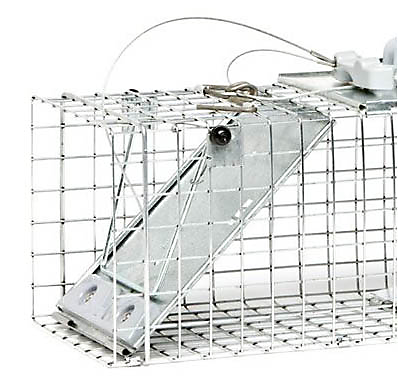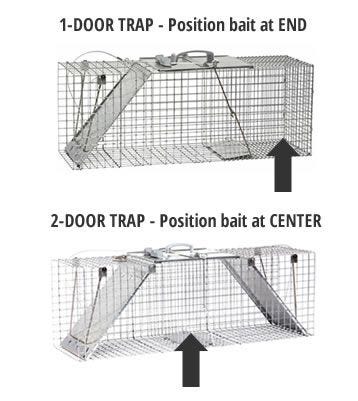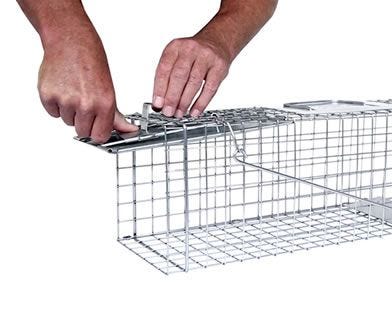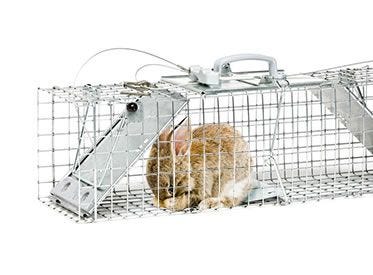






Rabbits
How to Trap Rabbits
Live rabbit trapping is one of the most effective methods of rabbit control, especially during colder months when repellents are less effective, or in areas of low rabbit density. Below, Havahart® provides step-by-step instructions teaching you how to trap a rabbit along with expert tips to help you along the way.
1 Eliminate Available Cover

Choose a mid-size trap that's around 22-30 inches in length. Most live rabbit traps come in 1-door or 2-door variations from which you can choose based upon your preferences - both are equally as effective for rabbits, but each has its own benefits:
| 1-Door |
|
| 2-Door |
|
2 Determine Trap Placement

- hedges
- shrubs
- fence lines
- brush piles
- tall grass
- woodpiles
- bushes
- tree lines
Place your trap in a spot where you see the most rabbit activity or damage. Rabbits spend most of their time along transitional areas where cover meets open land. Ideal locations include:
TIP: Rabbits will rarely cross a long stretch of open land, so avoid placing your trap in an area that would require rabbits to venture into vulnerable territory. If you locate a rabbit's warren or den, place your trap a few feet away from the entrance.

3 Select and Position Bait
- In warmer months when food is abundant, attract rabbits with rich fruits and veggies like apples or carrots.
- In the winter, avoid baits that contain a lot of water, which are prone to freezing. Dried alfalfa or dehydrated apples are ideal.
- The way in which you place your bait is just as important as the bait you choose. See the diagrams on the right for baiting techniques that will encourage your rabbit to step on the trigger plate.
- For more expert baiting tips, read How To: Rabbit Baits »
4 Carefully Set Your Trap

Following your trap's unique setting instructions - each Havahart® trap on the website has a video which demonstrates how to set the trap.
Once your trap is set, you can test the trigger by gently pressing on the trip plate. The doors should immediately snap closed with very little force.
TIP: If you believe your animal is on the smaller side and may not weigh enough to trip the trigger, you can place a small weight or rock on the trigger pan.
For the best trapping technology that's easy to set and release, check out our patented Easy Set® Traps »

5 Check Trap Often
Check your trap often to ensure that you attend to a trapped rabbit quickly after it's captured. A rabbit can quickly grow hungry when it's deprived of nourishment, so it should be released as soon as possible.
6 You've Caught a Rabbit!

- Wear gloves to protect yourself from a potential rabbit bite or transferrable disease.
- If local laws permit, relocate the rabbit at least 5 miles away. Try to release your rabbit in an area that offers plenty of cover for protection.
- If local laws permit, relocate the rabbit at least 5 miles away. Try to release your rabbit in an area that offers plenty of cover for protection.
- After letting the rabbit go, disinfect the cage with a bleach solution to remove your scent and prevent the potential to spread disease.
TIP: For the ultimate protection while carrying and releasing an animal, learn more about patented Easy Set® Technology »
7 Reduce Attractants

Make your yard less inviting to rabbits by reducing the availability of protective cover. Some steps you might take include:
- mowing grass
- raking leaves
- pulling weeds
- trimming back excess vegetation
- covering abandoned animal burrows
- cleaning up debris, woodpiles and brush
Maintain your yard diligently for best results.
Expert Tips
- Make sure to obey your local animal control laws when using a live rabbit trap.
- Do not keep a trapped wild rabbit as a pet. Wild rabbits can carry diseases transferrable to humans and other pets and should not be domesticated.
- Always wear gloves when handling a live trap - even when it’s empty. Gloves will not only protect you from a trapped animal but also prevent your scent from transferring onto the trap, making animals less wary of entering.
- When positioning your trap, be sure to do so on a flat, level surface. Place a weight or brick on top of the trap to prevent other animals from tipping the trap over to access the bait.
- A shiny, new trap can produce a glare that might be off-putting to rabbits and other animals. Reduce this glare by camouflaging your trap with twigs and leaves or rubbing dirt on it. Do not to let any camouflaging material get in the way of the trigger and close mechanism.
- To disinfect your trap, create a solution of 1 part bleach to 9 parts of water. Apply the solution, and wait 20 minutes before wiping down the trap.
- After removing rabbits with a live trap, keep them out with an effective rabbit repellent.

